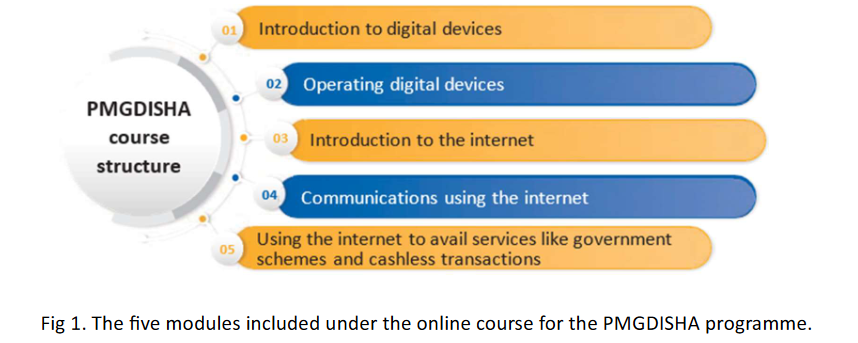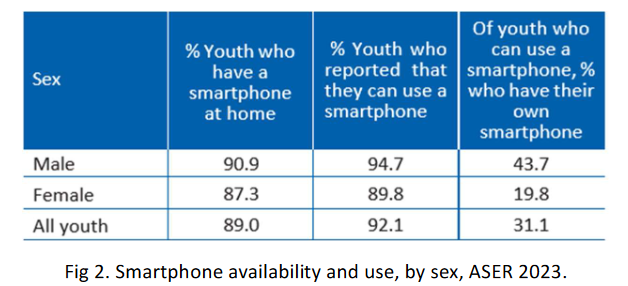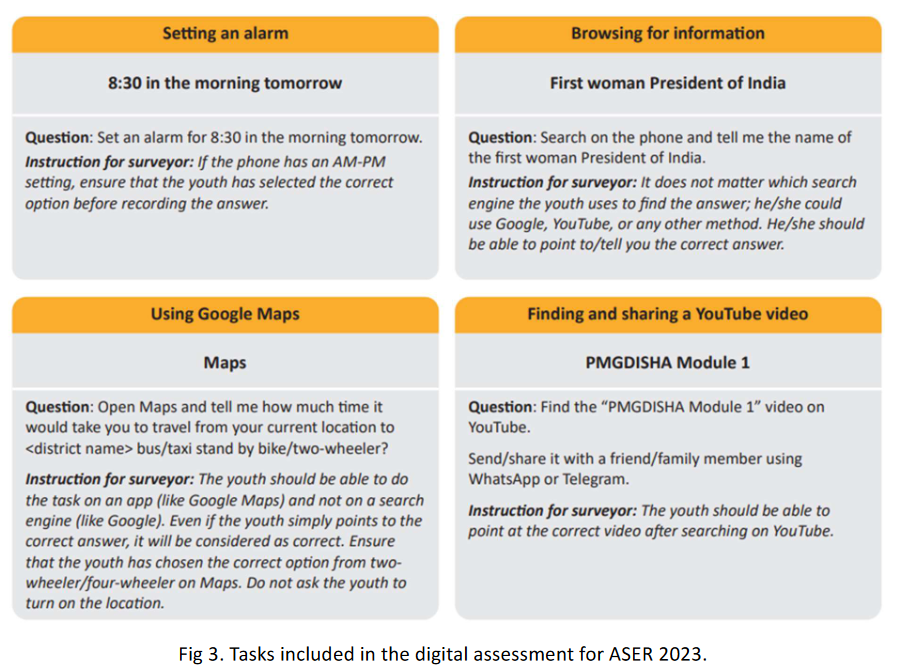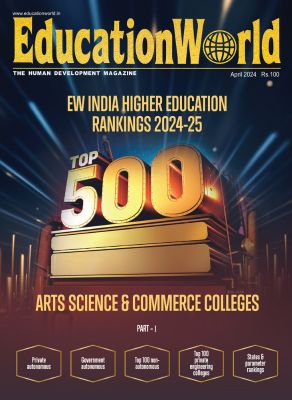– Disha Trivedi, Senior Research Associate at ASER Centre
The rapid pace of technological evolution in recent years has made digital literacy a key component of youth preparedness for the future. The importance of digital technologies was reinforced during COVID-19, which forced organizations and systems across sectors to innovate and find remote alternatives to conventional ways of working. Even as the world returned to normal, digital technologies remained embedded in people’s everyday lives. As we move forward, access to and mastery of digital technologies will significantly shape educational, economic, and social progress in every aspect of human endeavor. It will be crucial in realizing the much-anticipated “demographic dividend” and “digital dividend”.
The digital landscape in India has witnessed a massive transformation in recent years. Data from the ASER 2022 report show that smartphone ownership in rural India more than doubled (from 36% to 75%) between 2018 and 2022. According to another report published by the Internet and Mobile Association of India, more than 50% of new internet users will be from rural India by 2025.
The growing importance of digital literacy has been echoed at the central level – the National Education Policy 2020 makes many references to “digital literacy”, proposing the creation of a National Educational Technology Forum (NETF) which would be tasked with the use of technology in education. NEP 2020 charts various pathways to incorporate digitalization in all aspects of education.
Key goals among these are bridging the digital divide, leveraging existing technology for creating digital libraries, and improving blended modes of learning. With regard to initiatives on the ground, digital literacy and readiness became a national priority in 2015 with Digital India, the Indian government’s flagship mission that envisions transforming India into a ‘digitally empowered society and knowledge economy’ with ‘universal digital literacy’. To this effect, the government has incorporated digital elements across policies, kicked off several campaigns and programs to push the digital agenda, and set up several e-governance portals to provide its services online. One key initiative, the Pradhan Mantri Gramin Digital Saksharta Abhiyaan (PMGDISHA), is a flagship program of India’s Ministry of Electronics and Information Technology that aims to make one person in every Indian family digitally literate. The scheme is intended for citizens aged 14 to 60 years in rural India, specifically targeting vulnerable groups such as Scheduled Castes, Scheduled Tribes, Below Poverty Line (BPL) cardholders, and women.

However, a review of international literature suggests that there is no standard definition of digital literacy. Different frameworks have defined it for varying objectives and contexts. Reliable sources of data on digital skills, especially for India, remain scarce. The digital component of ASER 2023 was developed to explore what digital literacy could look like for youth in the age group 14-18 years in rural India. The survey was administered to about 35,000 youth across the country. ASER 2023 findings provide an interesting snapshot of the digital readiness of the rural Indian youth in this age group.
ASER data reveals that close to 90% of youth have a smartphone at home. An even higher proportion of both males and females report that they can use a smartphone. While access is almost universal, there are large gender gaps in smartphone ownership. The proportion of males who have their own smartphone is more than twice that of females. This gender disparity in ownership also bleeds into youth’s digital activities and abilities.

Almost all youth used smartphones for entertainment in the reference week, doing activities such as watching a movie, listening to music, or playing games. Close to 80% of all youth consumed entertainment content such as movies and music, and 56.6% played games on a smartphone. While entertainment is the most popular use of smartphones overall, there are notable differences by sex.
Data show that males are almost 10 percentage points more likely to have engaged in recreational use of smartphones. Despite the increasing digitization of government schemes and amid the push for digital payments, only about a quarter of the youth have ever used a smartphone to access services such as paying bills or booking tickets. The gender gap resurfaces here, and males are more than 15 percentage points more likely to have done at least one of these activities.
Interestingly, the gender gap nearly disappears for education-related activities. Over two-thirds of all youth report doing an activity related to their current education on a smartphone in the reference week, and this proportion is similar for both males and females. In addition to the self-reported questionnaire, youth were asked to bring an available smartphone and do some tasks on it. Tasks were administered orally, one-on-one, with a text prompt shown to the youth.

Among those who could bring a smartphone, browsing-related tasks were found the easiest by youth. About 80% could find a given video on YouTube and of those, nearly 90% could share it with a friend. Youths’ familiarity with browsing is also reflected in their ability to use the internet to find the answer to a question – 70% could do so. Setting an alarm is slightly more difficult, with two-thirds of youth being able to do so. The Google Maps task was the hardest, and under 40% of youth were able to successfully find the time taken to travel between two points on the map.

Males outperform females across all tasks. The gender gap is wider for tasks that are more difficult overall. For example, while the gap in browsing for information is minimal at about 2 percentage points, males outperform females by almost 25 percentage points in the Google Maps task. Digging a little deeper, when youths’ ability to do digital tasks is disaggregated by smartphone ownership, the gender gap decreases, and in some cases almost disappears. The only exception is the Google Maps task, where females do worse than males regardless of smartphone ownership status – perhaps a reflection of other restrictions placed on women, such as those related to mobility.
If youth have their own smartphone, they are likely to have relatively unrestricted access to explore and learn its functionalities, and hence are also more likely to acquire digital skills. Lower smartphone ownership relative to their male counterparts goes a long way towards explaining the gap in females’ self-reported use of smartphones and even their performance on digital tasks. The ASER 2023 exercise shines a spotlight on both achievements and limitations in the digital landscape in rural India. Youth have high levels of access, but need to be equipped with appropriate digital skills to adapt to an increasingly technology-reliant world. Specialized efforts are needed to close the gender gap in digital readiness. To formulate future policies, and to plan and design remedial programs, regular, large-scale data will be crucial.
Also read: ASER Report: 86.8% of Indian youths aged 14-18 enrolled in education
Posted in National, News



























